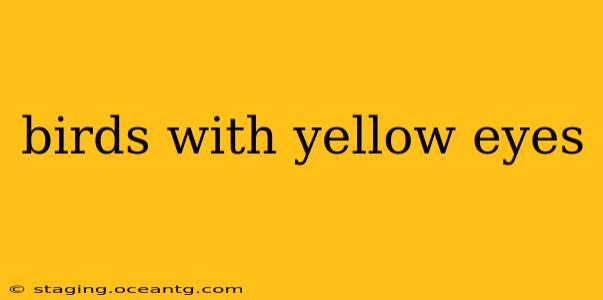Yellow eyes in birds are a captivating feature, often associated with a striking and sometimes predatory appearance. While not all birds with yellow eyes share the same characteristics, their vibrant gaze hints at unique adaptations and ecological niches. This article delves into the fascinating world of birds boasting these striking yellow eyes, exploring various species and the reasons behind this captivating trait.
What kind of birds have yellow eyes?
Many bird species exhibit yellow eyes, ranging from small songbirds to large raptors. Some common examples include:
- Owls: Several owl species, including the Great Horned Owl and the Barn Owl, possess striking yellow eyes. These bright eyes aid in low-light vision, crucial for their nocturnal hunting habits.
- Hawks and Eagles: Many diurnal raptors, like Red-tailed Hawks and Golden Eagles, have yellow eyes that enhance their sharp vision, vital for spotting prey from afar.
- Smaller Birds: Several smaller bird species, such as some species of finches and woodpeckers, also display yellow eyes, although the intensity and shade can vary greatly.
It's important to note that the shade of yellow can vary significantly depending on the species, age, and even the lighting conditions. Some may have a pale, almost golden yellow, while others boast a deep, intense yellow hue.
Why do some birds have yellow eyes?
The yellow color in bird eyes stems from pigments like carotenoids and lipochromes deposited in the iris. The exact reason for the prevalence of yellow eyes in certain species is complex and often linked to several factors:
- Camouflage: In some cases, yellow eyes might contribute to camouflage, blending the bird into its surroundings. This is particularly true for birds inhabiting environments with yellow or brownish tones.
- Sexual Selection: Bright yellow eyes can act as a sexually attractive trait, potentially increasing mating success. Males with more intensely colored eyes might be favored by females, leading to the evolution of brighter yellow eyes over generations.
- Communication: The intensity of eye color might serve as a signal of health and fitness to potential mates or rivals. Brighter, more vibrant yellow eyes could indicate superior genetic quality.
- Visual Acuity: In predatory birds, the yellow color might not directly enhance visual acuity, but the overall structure and size of the eye play a more significant role in their exceptional vision.
Are yellow eyes a sign of a bird's health?
While bright, clear eyes are generally a good indicator of a healthy bird, the color itself isn't a definitive marker of health. Other factors like feather condition, alertness, and behavior provide a much more comprehensive assessment of a bird's well-being. A dull or cloudy yellow eye, however, might suggest underlying health issues.
What does it mean if a bird has one yellow eye and one brown eye?
This is an unusual occurrence and often points to an injury or genetic anomaly. It's not a typical characteristic of any particular species. This could be due to trauma to one eye during development or a rare genetic mutation affecting eye pigmentation.
Do all birds of prey have yellow eyes?
No, not all birds of prey have yellow eyes. While many do, several species of hawks, eagles, and owls have different colored eyes, such as brown or orange. Eye color is just one of the many traits that differentiate bird species within the group of birds of prey.
Can a bird's eye color change?
Generally, a bird's eye color doesn't change significantly throughout its life. Any noticeable changes could indicate health problems or injury. However, subtle variations in shade due to lighting or age are possible.
In conclusion, the prevalence of yellow eyes in birds is a fascinating aspect of avian diversity, reflecting complex evolutionary pressures and ecological adaptations. While the precise reasons for yellow eyes vary across species, their striking appearance continues to capture the attention and curiosity of bird enthusiasts worldwide.
